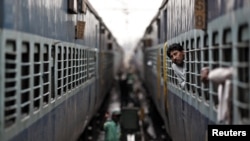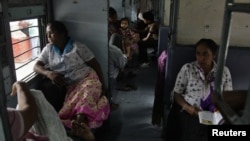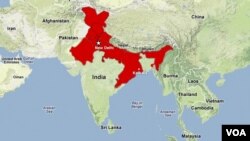NEW DELHI — India suffered a second day of a massive power breakdown that affected nearly half the country on Tuesday. India experienced its worst-ever power crisis, leaving more than 650 million people without electricity.
India's transport system screeched to a halt for a second day, as trains stopped and traffic signals stalled -- stranding passengers and drivers.
Coal 56.65%
Hydro 19.13 %
Renewable: 12.09%
Gas 9.20%
Nuclear 2.32%
Oil 0.58%
Source: India Ministry of Power
Three electricity grids failed Tuesday, with power cut from as far north as Kashmir to the eastern state of Assam. The lights went out in major cities like the capital New Delhi and the eastern city of Kolkata shortly after 1 p.m. local time.
It was the second day that India suffered a blackout - but this time it hit a far larger part of the country. On Monday, an outage affected seven northern states, leaving more than 300 million people without electricity for nearly ten hours. On Tuesday, more than a dozen states were hit.
[Indian media reports power was restored in most of the Indian capital late Tuesday, allowing train service to resume and for traffic lights to come back to life. Officials said power was also being restored to other parts of the country, though estimates for how long it would take to get everyone back online varied.]
Power Minister Sushilkumar Shinde blamed the collapse of the power system on states using more power than they were authorized. “The reason is overdrawing of power by many states. I have put in all my people at the job, we are getting power from the western region and some other places," Shinde said. "Alternative arrangements have been made.”
Minister Shinde said states which use more power than authorized will be penalized.
Officials say a long, hot summer and a deficient monsoon season has increased demand for power as farmers irrigate fields in rural areas and city residents run their air conditioners far longer than usual.
The massive power failure for two straight days has turned the spotlight on India’s electricity deficit. Analysts have long said that the country’s power requirements have failed to keep pace with the demands of an expanding economy and a growing population. As a result, outages for several hours a day are routine across much of the country.
But a complete collapse of the kind witnessed for two straight days is unprecedented.
A former adviser to the government on power, V. Raghuraman, said India can generate more electricity, but many power plants are lying idle because they do not have sufficient fuel. “The private sector has added enough capacity. There is not enough coal and gas so you find power is not being generated,” Raghuraman explained.
Observers say the lack of adequate infrastructure is holding back economic growth and discouraging investors -- both domestic and foreign.
India's transport system screeched to a halt for a second day, as trains stopped and traffic signals stalled -- stranding passengers and drivers.
India's Power Sources
India's Power SourcesCoal 56.65%
Hydro 19.13 %
Renewable: 12.09%
Gas 9.20%
Nuclear 2.32%
Oil 0.58%
Source: India Ministry of Power
It was the second day that India suffered a blackout - but this time it hit a far larger part of the country. On Monday, an outage affected seven northern states, leaving more than 300 million people without electricity for nearly ten hours. On Tuesday, more than a dozen states were hit.
[Indian media reports power was restored in most of the Indian capital late Tuesday, allowing train service to resume and for traffic lights to come back to life. Officials said power was also being restored to other parts of the country, though estimates for how long it would take to get everyone back online varied.]
Power Minister Sushilkumar Shinde blamed the collapse of the power system on states using more power than they were authorized. “The reason is overdrawing of power by many states. I have put in all my people at the job, we are getting power from the western region and some other places," Shinde said. "Alternative arrangements have been made.”
Minister Shinde said states which use more power than authorized will be penalized.
Officials say a long, hot summer and a deficient monsoon season has increased demand for power as farmers irrigate fields in rural areas and city residents run their air conditioners far longer than usual.
The massive power failure for two straight days has turned the spotlight on India’s electricity deficit. Analysts have long said that the country’s power requirements have failed to keep pace with the demands of an expanding economy and a growing population. As a result, outages for several hours a day are routine across much of the country.
But a complete collapse of the kind witnessed for two straight days is unprecedented.
A former adviser to the government on power, V. Raghuraman, said India can generate more electricity, but many power plants are lying idle because they do not have sufficient fuel. “The private sector has added enough capacity. There is not enough coal and gas so you find power is not being generated,” Raghuraman explained.
Observers say the lack of adequate infrastructure is holding back economic growth and discouraging investors -- both domestic and foreign.








